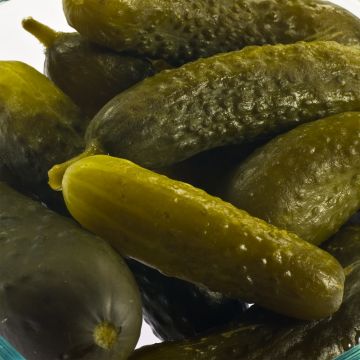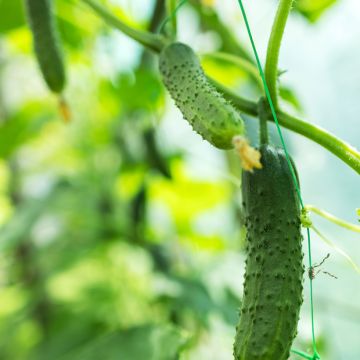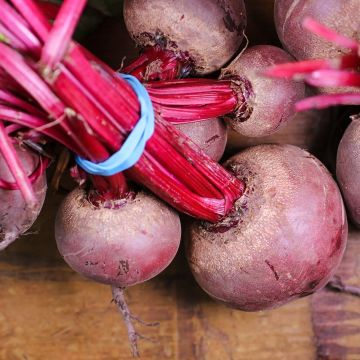

Cucumber Levina F1 - Cucumis sativus


Cucumber Levina F1 - Cucumis sativus
Cucumber Levina F1 - Cucumis sativus
Cucumis sativus Levina F1
Cucumber, Gherkin
Why not try an alternative variety in stock?
View all →This plant carries a 6 months recovery warranty
More information
We guarantee the quality of our plants for a full growing cycle, and will replace at our expense any plant that fails to recover under normal climatic and planting conditions.
Seed-only orders are dispatched by sealed envelope. The delivery charge for seed-only orders is €3.90.
Description
The Levina F1 Gherkin is a disease-resistant variety (downy mildew, powdery mildew, and mosaic virus) that produces fruits that are dark green, covered in small bumps, and without bitterness. It is a high-quality cucumber, very flavourful and high-yielding. Sowing from March to June for harvesting from July to October.
Gherkins and cucumbers belong to the same species, but gherkins are picked prematurely to be pickled in vinegar, accompanied by small onions, peppercorns, and tarragon.
It is a vegetable that can be stored for a long time and is traditionally enjoyed in salads or to accompany cold dishes.
Gherkins prefer light, loose, moist, and humus-rich soils. They like sunny exposures and temperatures between 18 and 22°C (64.4 and 71.6°F). They are quite water-demanding vegetables that need regular watering.
Some varieties are labelled "F1 hybrid" or "F1", which means they are the result of carefully selected parent cross-breeding to combine their qualities. This results in varieties that can be particularly flavourful and/or early-maturing while also being resistant to certain diseases. F1 hybrid seeds are therefore very interesting for their uniformity and resistance, but unfortunately, these qualities do not pass on to the next generation: it will not be possible to save the seeds for the following season.
Harvest: Gherkins should be harvested 3 to 4 months after sowing and before the fruits reach their final size. It should be done very regularly, ideally every two days during the peak production period, as they grow rapidly and will quickly transform into cucumbers, depending on the variety! Additionally, regular harvesting encourages the formation of new fruits.
Storage: Freshly harvested gherkins can be stored for a few days in the refrigerator before being pickled in vinegar.
Gardener's tip: Like all cucurbits, gherkins can be susceptible to powdery mildew: a white coating appears on the leaves. It is important to remove heavily affected leaves and spray with sulfur every 2 weeks. In case of minor infection, you can also treat the plants with skimmed milk diluted at 10 to 20% in rainwater. As a preventive measure, avoid watering the foliage and ensure proper ventilation in your greenhouse if growing under cover. An extract of horsetail can also be sprayed to strengthen leaf resistance.
Report an error about the product description
Harvest
Plant habit
Foliage
Botanical data
Cucumis
sativus
Levina F1
Curcubitaceae
Cucumber, Gherkin
Cultivar or hybrid
Annual
Other Gherkin seeds
Planting and care
Sowing:
Cucumber germination occurs at a temperature between 16°C (60.8°F) and 35°C (95°F). The seedlings usually emerge within 8 to 10 days.
Sowing can be done from March to June in pots or directly in the ground:
In pots, one month before the intended planting date, place 2 or 3 seeds in a special seed compost and water with a very fine spray. When the two true leaves appear, keep only one plant per pot. Keep the young plant at a mild temperature, making sure the substrate remains moist but not waterlogged.
Sowing directly in the ground is done later, in well-warmed soil: sow in holes with 2 or three seeds and proceed as for pot sowing.
During planting or direct sowing, maintain a distance of one metre between each row and 50 to 60cm (20 to 24in) between each plant.
Cultivation:
Cucumbers are quite demanding vegetables that require well-fertilised soil. It is advisable to apply compost (about 3 kg per m2) in autumn, by scratching it into the soil to a depth of 5cm (2in), after loosening the soil as for any vegetable cultivation. They prefer neutral soils (pH 7) but will also thrive in slightly acidic or alkaline soils (pH between 5.5 and 7.5).
Cucumbers can be grown flat, but to save space, don't hesitate to train them as climbers: on a frame covered with a trellis, inclined at 45 degrees (113°F), they will provide beneficial shade for lettuce or even in a tipi to add some whimsy to the vegetable garden.
When the plants are trained vertically, the cultivation is done with a single stem that will be pinched out at a height of 2.5 metres (8 feet). When grown flat, pinch above the second leaf to obtain two stems, which will then be pinched above the 4th leaf. The final pruning consists of cutting above a leaf for each formed fruit.
Cucumbers go well with corn, but avoid planting them near tomatoes and potatoes.
Seedlings
Care
Intended location
This item has not been reviewed yet - be the first to leave a review about it.
Vegetable seeds
Haven't found what you were looking for?
Hardiness is the lowest winter temperature a plant can endure without suffering serious damage or even dying. However, hardiness is affected by location (a sheltered area, such as a patio), protection (winter cover) and soil type (hardiness is improved by well-drained soil).

Photo Sharing Terms & Conditions
In order to encourage gardeners to interact and share their experiences, Promesse de fleurs offers various media enabling content to be uploaded onto its Site - in particular via the ‘Photo sharing’ module.
The User agrees to refrain from:
- Posting any content that is illegal, prejudicial, insulting, racist, inciteful to hatred, revisionist, contrary to public decency, that infringes on privacy or on the privacy rights of third parties, in particular the publicity rights of persons and goods, intellectual property rights, or the right to privacy.
- Submitting content on behalf of a third party;
- Impersonate the identity of a third party and/or publish any personal information about a third party;
In general, the User undertakes to refrain from any unethical behaviour.
All Content (in particular text, comments, files, images, photos, videos, creative works, etc.), which may be subject to property or intellectual property rights, image or other private rights, shall remain the property of the User, subject to the limited rights granted by the terms of the licence granted by Promesse de fleurs as stated below. Users are at liberty to publish or not to publish such Content on the Site, notably via the ‘Photo Sharing’ facility, and accept that this Content shall be made public and freely accessible, notably on the Internet.
Users further acknowledge, undertake to have ,and guarantee that they hold all necessary rights and permissions to publish such material on the Site, in particular with regard to the legislation in force pertaining to any privacy, property, intellectual property, image, or contractual rights, or rights of any other nature. By publishing such Content on the Site, Users acknowledge accepting full liability as publishers of the Content within the meaning of the law, and grant Promesse de fleurs, free of charge, an inclusive, worldwide licence for the said Content for the entire duration of its publication, including all reproduction, representation, up/downloading, displaying, performing, transmission, and storage rights.
Users also grant permission for their name to be linked to the Content and accept that this link may not always be made available.
By engaging in posting material, Users consent to their Content becoming automatically accessible on the Internet, in particular on other sites and/or blogs and/or web pages of the Promesse de fleurs site, including in particular social pages and the Promesse de fleurs catalogue.
Users may secure the removal of entrusted content free of charge by issuing a simple request via our contact form.
The flowering period indicated on our website applies to countries and regions located in USDA zone 8 (France, the United Kingdom, Ireland, the Netherlands, etc.)
It will vary according to where you live:
- In zones 9 to 10 (Italy, Spain, Greece, etc.), flowering will occur about 2 to 4 weeks earlier.
- In zones 6 to 7 (Germany, Poland, Slovenia, and lower mountainous regions), flowering will be delayed by 2 to 3 weeks.
- In zone 5 (Central Europe, Scandinavia), blooming will be delayed by 3 to 5 weeks.
In temperate climates, pruning of spring-flowering shrubs (forsythia, spireas, etc.) should be done just after flowering.
Pruning of summer-flowering shrubs (Indian Lilac, Perovskia, etc.) can be done in winter or spring.
In cold regions as well as with frost-sensitive plants, avoid pruning too early when severe frosts may still occur.
The planting period indicated on our website applies to countries and regions located in USDA zone 8 (France, United Kingdom, Ireland, Netherlands).
It will vary according to where you live:
- In Mediterranean zones (Marseille, Madrid, Milan, etc.), autumn and winter are the best planting periods.
- In continental zones (Strasbourg, Munich, Vienna, etc.), delay planting by 2 to 3 weeks in spring and bring it forward by 2 to 4 weeks in autumn.
- In mountainous regions (the Alps, Pyrenees, Carpathians, etc.), it is best to plant in late spring (May-June) or late summer (August-September).
The harvesting period indicated on our website applies to countries and regions in USDA zone 8 (France, England, Ireland, the Netherlands).
In colder areas (Scandinavia, Poland, Austria...) fruit and vegetable harvests are likely to be delayed by 3-4 weeks.
In warmer areas (Italy, Spain, Greece, etc.), harvesting will probably take place earlier, depending on weather conditions.
The sowing periods indicated on our website apply to countries and regions within USDA Zone 8 (France, UK, Ireland, Netherlands).
In colder areas (Scandinavia, Poland, Austria...), delay any outdoor sowing by 3-4 weeks, or sow under glass.
In warmer climes (Italy, Spain, Greece, etc.), bring outdoor sowing forward by a few weeks.
























































